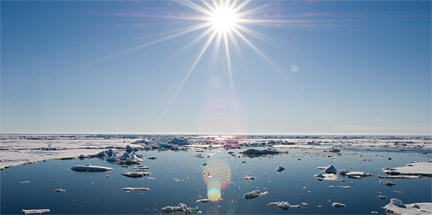We’ve all probably heard of global warming at one time or another, maybe on the news or in a magazine. But did we really think about its meaning? Did we contemplate its effect on the world? To start, we should know the definition of global warming. It sounds confusing, but it’s really not when explained correctly in simple terms. In the Merriam Webster Dictionary, global warming is defined as, “the recent increase in the world’s temperature that is believed to be caused by the increase of certain gases (such as carbon dioxide) in the atmosphere.” What does this mean? Many greenhouse gases, such as carbon dioxide, are being released into the air. This is the effect of burning fossil fuels. This traps heat in the Earth’s atmosphere, instead of releasing it. So, why does this matter? Global warming is raising the Earth’s temperature, especially in the Arctic. This may not seem like a big deal…until we find out the negative effects.

Up in the Arctic, polar bears are losing their habitat to the rising temperatures. Polar bears spend their days primarily in the sea and on ice. They need a platform of ice to hunt for their prey, seals. However, the ice is melting away. It’s getting more difficult for polar bears to get food for survival. During the summer, seasonal ice melts. When this happens, polar bears have the option of swimming to other patches of ice to hunt or simply starving until the fall, when the ice refreezes. Every year, the time period in which it takes for the ice to freeze again is growing. Polar bears cannot go without food forever. The other choice, swimming to other patches of ice for the summer, is becoming just as difficult. Less of the ice refreezes each year. The edges of the patches are steadily receding. Polar bears have to swim farther and farther to find frozen icecaps. Imagine swimming 400 miles without rest. Some do not make the long tiring journey. As a result, the polar bear population is rapidly decreasing.

As an animal lover, this is an important matter to me. Many different species are dying out due to various reasons. The population of many Arctic animals is lowering significantly due to the rising temperatures. Habitats are melting away, food supplies are diminishing. To fully understand the situation, think about it this way. Imagine that every day, a very small portion of your house is taken away. Not only that, a little bit of your food disappears each week also. At first, your living conditions would be cramped and uncomfortable. Eventually, your whole house and all of your food would be gone, leaving you homeless and starving. This is what is happening to polar bears in the Arctic. What can be done to help?
We must remember that the negative outreaches of global warming are not just limited to polar bears. This growing problem is spreading. Organizations fighting to keep the issue under control include Sierra Club and 350.org. Many people are dedicated and passionate about helping preserve the earth and its inhabitants and natural resources. If you want to get involved, don’t hesitate to check out these websites. Help make a difference!
~Ruth
